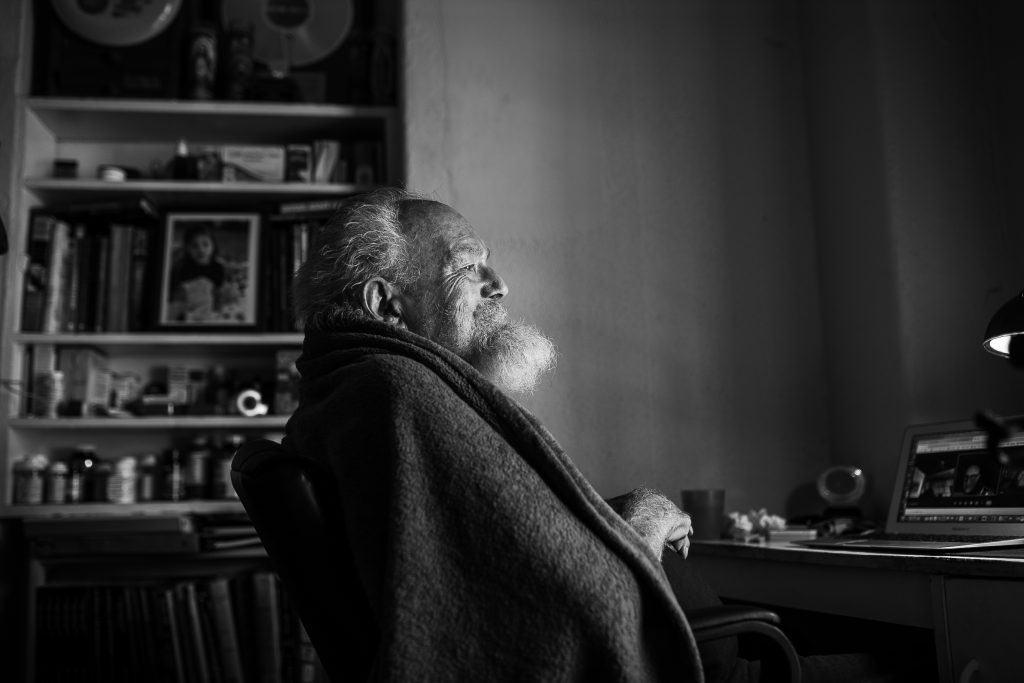The afternoon light peeks into John SinclairвҖҷs room and dances in and out of the smoke swirling up from his recently lit joint. HeвҖҷs sitting at his desk, on a Zoom call, discussing jazz, blues, and rock music with people in the United Kingdom interested in his layered and historic roles in the world of music.
His apartment is tucked away on the top floor of a remodeled multilevel Victorian home in downtown Detroit. Paintings, photographs, and books fill the nooks, shelves, and fireplace mantle in his home.
Sinclair, now 81 and a Flint native, is best known for his activism, writing, and love for music and has been referred to as the вҖңfather of marijuana legalization.вҖқ
In 1967, Sinclair was nearing a decade of prolific activism in the hippiesвҖҷ counterculture revolution. That same year, he was arrested for marijuana possession (for selling joints to undercover FBI agents). In 1969, he was sentenced to 10 years in prison.
More than a half a century later, Sinclair is no longer holding rallies or fighting in the streets. Now, his focus has shifted to cataloging his works, his life, and his legacy. To be a real revolutionary, Sinclair says, going to prison is what you do: вҖңItвҖҷs part of the job.вҖқ

Locked up
In protest of his imprisonment, on Dec. 10, 1971, photographer Leni Sinclair (his former wife) and fellow activists held the , a sold-out event at Crisler Arena (now Crisler Center) in Ann Arbor. Black Panther Party co-founder Bobby Seale, Allen Ginsberg, and Rennie Davis spoke at the rally, which also featured performances by Bob Seger, Stevie Wonder, and John Lennon.
Three days later, Sinclair was released from prison. He continued to appeal his case, and on March 9, 1972, the Supreme Court ruled that the 1952 law that classified marijuana as a narcotic and was used to imprison Sinclair was unconstitutional. The state legislature passed a new, less strict law on marijuana that didnвҖҷt go into effect until April 1 of that year вҖ” due to SinclairвҖҷs battle with the courts, weed was technically legal in Michigan for 22 days.
Sinclair finishes his online meeting, and he turns and smiles at me. вҖңLetвҖҷs go sit outside on my little piece of heaven.вҖқ He reaches for his walker, taking a moment to stand, and I follow him to his back deck.
The wooden deck floor sits level with the surrounding Victorian brick homesвҖҷ rooftops. His chair has a direct view of the Renaissance Center towering over alleyways, each filled with pockets of light and shadows вҖ” literally a slice of heaven.
Sinclair rests in the shade of an umbrella and unravels more of his backstory.
He co-founded the White Panther Party alongside Leni Sinclair and Pun Plamondon, in support of the Black Panthers. His activism drove his pen to paper, and he became a journalist. He founded the Ann Arbor Sun with legendary rock вҖҷnвҖҷ roll artist Gary Grimshaw and Leni. The underground newspaper helped spread information about ongoing civil rights issues, as well as musicians and artists from underrepresented communities.
вҖңOh, I loved it [living in Ann Arbor]. We turned it all around,вҖқ Sinclair says. вҖңWe organized all the hippies. We had free concerts in the parks everywhere, we had the food co-op, and we had the [Free PeopleвҖҷs Clinic].вҖқ

From music to activism
SinclairвҖҷs activism and admiration of Black and brown people and culture started long beforeМэhe ever smoked weed. His lifeвҖҷs journey really started the first time he heard blues music on the radio.
вҖңI grew up in the вҖҷ40s, before television,вҖқ Sinclair says. вҖңThe radio was the entertainment media. All the programs were on the radio: the dramas, soap operas, comedy reviews.
вҖңAt the time, I was like 10 years old, and I was used to listening to the radio in the morning when I woke up. I came across this Black station, and it was playing rhythm and blues. I thought, вҖҳJesus Christ, this shit sounds good.вҖҷ The high point of culture in my house was watching Ed Sullivan at night. So, hearing that on the radio just blew me away. I started listening to it every day, and it just became a way of life for me.вҖқ
Sinclair spent his life surrounding himself with artists and musicians, whether he was living in Detroit, Ann Arbor, New Orleans, or Amsterdam. And he always maintained a personal conviction that, to truly appreciate the cultural works of minority groups, he had to be an advocate for civil rights. He had to be part of the revolution.
вҖңWe wanted free, legal backyard marijuana вҖ” that was our slogan,вҖқ Sinclair says. вҖңIt was rough. It started in 1962, and it took us 60 years. ItвҖҷs been a long time.вҖқ

His way of life has slowed down a little in the past few years, because of ongoing health issues, but his heart and mind continue to grow and shed light on issues so easily forgotten.
He has promoted the work of artists of color his entire career. He has written hundreds of poems and cataloged the works of other artists and musicians as well. The roster of jazz and blues artists heвҖҷs met and worked with is legendary. Sinclair shook hands with R.L. Burnside inside BurnsideвҖҷs home trailer. He met and watched Junior Kimbrough, Muddy Waters, and the likes play their music in person. And he continues to associate with living blues artists like Kenny Brown.
The sun starts to set, and his daughters arrive to check on their father and spend the evening with him. His daughter Celia sits next to us on the deck and proudly smiles as she watches her father talk about his legacy and his love for life.
SinclairвҖҷs focus shifts the conversation to life in the present. He is cataloging his works, finishing his books, and running his radio station, . вҖңIвҖҷm trying to prepare my legacy, because I donвҖҷt have much time left.вҖқ
Celia brings me a warm cup of pour-over coffee and a heavy hardcover book. On the matte leaflet, the title reads, Motor City Underground: Leni Sinclair Photographs 1963-1978. In it is a small note written to John Sinclair from Leni: вҖңFor John: This will take you down the memory lane thatМэwe traveled together. It could not have happened without you вҖ” I know. So thanks for all the good memories. Leni. April 19, 2021.вҖқ
Every page is lined with stunning black-and-white photographs. Each page unfolds moments in history, with images of the Black Panthers feeding the community, Marvin Gaye performing live in Detroit, John Coltrane playing the sax, and Sinclair with big curly dark hair holding Celia, then a baby girl.

SinclairвҖҷs low and raspy voice fills the evening air as he relays memories attached to each image, as I turn the pages. His face, framed with gray and silver, still holds his warm and welcoming smile. His laugh, an almost identical Seth Rogen stoner chuckle, ripples around us as Celia and I listen to each photographвҖҷs backstory.
SinclairвҖҷs activism and willingness to fight in the вҖҷ60s counterculture revolution paved the way for the legalized marijuana of today. His words and his work have helped to create the freedom to enjoy small moments like the ones we shared on his patio. He envisioned a world where change is possible.
In the poem вҖңSpiritualвҖқ by Sinclair, he reflects on the raw humanness of blues and jazz music. His love for the rich soul and sounds of both genres changed the trajectory of his life. It is in his works that we will forever be able to understand the power of his legacy.
вҖңWhat is blues,вҖқ Sinclair asks in the poem, but a вҖңprayer / to the gods of daily life / to ask the blessing / that the body of another / may lay warm in the bed / beside you at night, & the rent / be paid, & a meal / on the table, with the sheriff / far away / from the scene of the crime.вҖқ
This story is from the DecemberМэ2022 issue of ПгёЫБщәПІКНјҝвЧКБП magazine. Read more in our digital edition. Check out part two of вҖҳWhere ThereвҖҷs Smoke, ThereвҖҷs Fire,вҖҷ an interview with Najanava Harvey-Quinn, activist and managing director of Clean Smoke Community Investment Project,Мэ
|
| Мэ |
|








